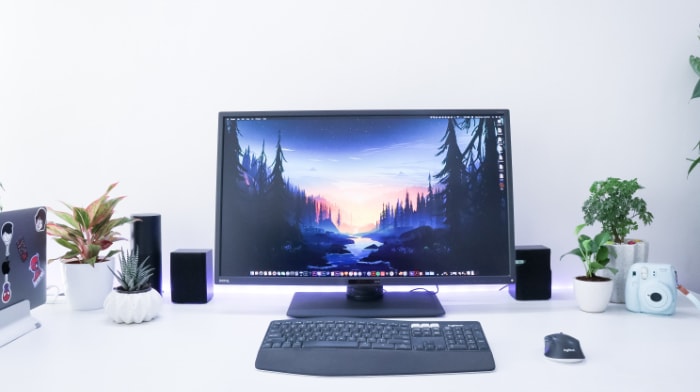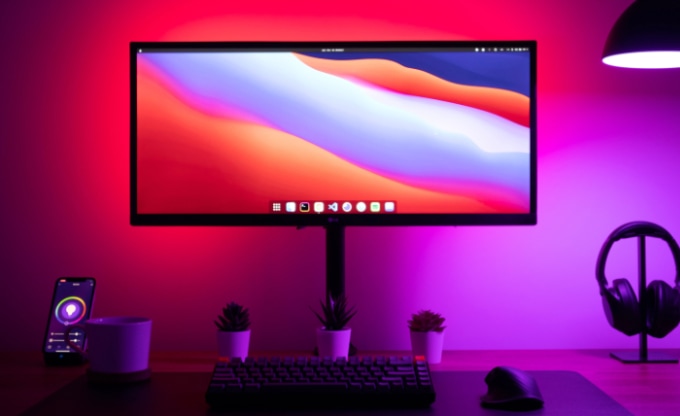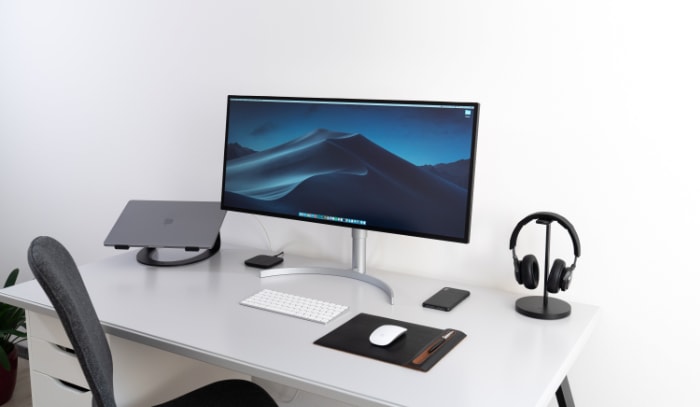Why Does My Monitor Randomly Go Black? Troubleshooting 101

Navigating the digital world requires a functional display screen or monitor, as it’s the primary interface between the user and the computer system. One of the most common yet perplexing issues that users often face is the “monitor randomly goes black” problem.
This situation not only disrupts the seamless user experience but also hampers productivity, especially if your work heavily depends on the computer.
In essence, the issue manifests as the monitor unexpectedly turning black while the system is in use. It may happen without any warning or error message, causing a significant disruption, particularly if you’re in the middle of an important task.
The frequency and duration of these blackouts can vary from occasional to regular, and from a few seconds to indefinitely until a restart.
Understanding The Issue
Before diving into the specific troubleshooting steps, it’s critical to understand the issue at hand. Here, we will explore what exactly it means when a monitor randomly goes black, potential causes of the problem, and the impact it can have.
What Does ‘Monitor Randomly Goes Black’ Mean?
The phrase “monitor randomly goes black” refers to an unexpected and unanticipated situation where the computer screen suddenly turns black or blank while the system is in use. This issue can occur without any prior warning or apparent trigger.
Importantly, even though the screen turns black, the computer itself often continues to operate – you might still hear audio or see indicator lights that suggest the computer is functioning.
Potential Causes of the Problem
Numerous factors can lead to this problem, making it somewhat challenging to pin down a specific cause without a thorough investigation. The issue might be as minor as a loose cable connection, or as significant as a failing graphics card or monitor.
In some cases, it could be software-related, such as outdated drivers or a problematic operating system update. Sometimes, it could also be due to a power supply issue, where the monitor is not receiving sufficient power to keep the display on.
The Impact of the Issue
The consequences of a monitor that randomly goes black are predominantly centered around disruptions to productivity and user experience. For instance, if you are in the midst of an important work assignment, a presentation, or a competitive gaming session, this issue could lead to data loss, missed deadlines, or even a lost game.
The problem becomes even more critical if it happens frequently or if the screen stays black for prolonged periods.
Basic Troubleshooting Techniques
Now that we’ve grasped the nature of the problem, let’s begin with some basic troubleshooting techniques. These initial steps are easy to perform and often solve many common issues, including a monitor that randomly goes black.
Checking Connections
The first step in troubleshooting your monitor issue is to verify all the physical connections. Make sure the monitor’s power cable is securely connected to the power outlet, and the video cable (such as HDMI, DVI, VGA, or DisplayPort) is firmly attached at both ends – to the monitor and the computer’s graphics port.
If your system uses a detachable power cable, ensure it’s properly connected to the monitor. Loose or weak connections are one of the most common reasons for a black screen.
Restarting Your System
Once you have ensured that all cables are properly connected, the next simple troubleshooting step is to restart your system. A good old reboot can clear out any temporary software glitches that may be causing your monitor to blackout.
Remember to save all your open work before you restart to prevent any data loss.
Trying a Different Display Port
If your computer has multiple display ports (like more than one HDMI, DVI, or DisplayPort), try plugging your monitor cable into a different port. Occasionally, a specific port might encounter issues due to hardware faults or software conflicts, so switching to another one can help identify if the port is the problem.
Trying a Different Monitor, If Possible
If you have access to another monitor, connecting it to your system can help determine if the issue is with your original monitor or the computer itself. If the substitute monitor works without any blackouts, it’s likely that your original monitor is faulty.
Conversely, if the second monitor also experiences blackouts, the issue likely lies within your computer, possibly with your graphics card, operating system, or power supply.
Software-Related Causes and Solutions

Having tried the basic steps, if the problem persists, it’s possible the cause is within the software realm. This section discusses software-related issues that can lead to the monitor blackout issue, and ways to resolve them.
Graphic Drivers – Updating or Reinstalling
Your graphics card’s driver plays a crucial role in displaying visuals on your monitor. If this driver is outdated, corrupted, or incompatible, it can cause your monitor to go black. To resolve this, update your graphics driver to the latest version available from your graphics card manufacturer’s website.
If updating doesn’t solve the issue, try completely uninstalling the driver, then reinstalling it.
Screen Saver and Power Saving Settings
Your computer’s screen saver and power-saving settings could also cause the monitor to blackout, especially if these settings are configured to turn off the display after a certain period of inactivity. Check these settings in your operating system’s control panel or system preferences.
If they’re set to turn off the screen too quickly, adjust them to suit your usage pattern better.
Operating System Glitches
Sometimes, issues with the operating system itself can lead to a randomly blacking out monitor. These might be caused by faulty updates, system file corruption, or other software conflicts.
Running a system file check (like the “sfc /scannow” command on Windows) can help identify and fix any corrupt system files. If you recently installed a new update or software before the issue started, try uninstalling that update or software to see if it resolves the problem.
Malware or Virus Causing the Issue
Malware or viruses can also cause monitor blackouts. These malicious software elements can interfere with system processes, including those controlling the display.
Running a comprehensive antivirus scan can detect and remove any such threats. Remember, always keep your antivirus software up to date to ensure maximum protection.
In the digital world, software issues are often the culprits behind various glitches, including a monitor randomly going black. While the above methods can resolve most software-related causes, remember to always back up your data before attempting any major software troubleshooting or changes.
Hardware-Related Causes and Solutions
Not all issues stem from software – sometimes, the hardware could be at fault. In this part, we explore potential hardware-related causes for your monitor going black, along with appropriate solutions.
Issues with the Video Card
The video card, or graphics card, is a crucial component responsible for delivering images to your monitor. If it’s faulty or failing, it can result in your monitor going black.
Indications of a problematic video card include artifacting (strange lines, shapes, or colors on the screen), system crashes when performing graphically intensive tasks, or even failure to boot. Resolving this may require replacing the video card or, in the case of integrated graphics, potentially the entire motherboard.
Overheating
Overheating can also lead to your monitor randomly blacking out. If your computer or graphics card becomes too hot, they may shut off or reduce performance to cool down, potentially causing the screen to go black.
Regularly cleaning out dust and ensuring proper ventilation can prevent overheating. If your system is consistently running hot, you may need to consider additional cooling solutions or look for hardware malfunctioning and causing excess heat.
Monitor Issues
The problem could lie within the monitor itself. If the monitor’s power supply, internal components, or backlight are failing, it could cause the screen to go black.
Symptoms of this include the screen blacking out but power lights remaining on, screen flickering, or distortions before the screen goes black. Depending on the monitor’s age and cost, you may need to weigh up the cost-benefit of repairing versus replacing the monitor.
Power Supply
If your computer’s power supply (PSU) is faulty, it might not provide adequate power to run your system, including the graphics card, which can lead to a black screen. Signs of a failing PSU can be system instability, random restarts, or failure to power up. Resolving this issue typically involves replacing the power supply.
While hardware issues can be more daunting to resolve than software problems, they’re equally important to consider in troubleshooting. Identifying and fixing hardware-related issues often require some level of technical knowledge. If you’re not comfortable handling computer hardware, consider seeking professional help.
Advanced Troubleshooting

If the problem still stands after basic troubleshooting and checking for software or hardware issues, we might need to dig deeper. This section will guide you through some advanced troubleshooting techniques that can help tackle the issue.
BIOS/UEFI Settings Related to Graphics and Display
The Basic Input Output System (BIOS) or Unified Extensible Firmware Interface (UEFI) settings can affect your computer’s display, and misconfigurations here could lead to your monitor randomly going black. Accessing these settings involves restarting your computer and pressing a specific key (like F2, F10, or Del) during startup.
Inside, you might find settings related to your graphics card, integrated graphics, or display that you can adjust. Be careful, though – changing the wrong setting can cause other issues, so it’s important to document any changes you make so they can be reversed if necessary.
Running Hardware Diagnostic Tests
Some issues, like problems with the RAM or hard drive, might indirectly cause monitor blackouts. Running hardware diagnostic tests can help identify such issues. Many computer manufacturers provide diagnostic tools that can be accessed during startup or downloaded from their website.
There are also third-party tools available for testing various components.
When to Seek Professional Help
If you’ve tried all the basic, software-related, and hardware-related troubleshooting steps and are still experiencing the issue, it might be time to seek professional help. This could involve contacting your computer or monitor manufacturer’s customer support, a local computer repair shop, or a tech-savvy friend.
Be sure to provide them with as much detail as you can about the issue and the steps you’ve already taken.
Conclusion
We’ve embarked on a comprehensive journey exploring the issue of a monitor randomly going black, ranging from understanding its root causes to various troubleshooting strategies. As we’ve seen, this common problem can stem from a variety of sources, including both software-related and hardware-related aspects.
We started with simple steps like checking physical connections and restarting your system, moved on to tackle software issues such as graphic driver updates and power saving settings, and then dived into hardware components that might be at fault. We even touched upon advanced troubleshooting involving BIOS/UEFI settings and diagnostic tests.
The essential takeaway is that there’s no one-size-fits-all solution to this issue. The key is to remain patient, systematic, and thorough in your approach, starting from basic troubleshooting and gradually progressing to more advanced techniques if needed.
Remember that professional help is available if the problem persists or if you’re not comfortable navigating more technical steps. Always back up your data before undertaking any significant troubleshooting measures to avoid unintentional data loss.
Ultimately, while it’s crucial to know how to troubleshoot when things go wrong, it’s equally important to maintain your system regularly to prevent such issues from occurring in the first place. In the realm of technology, an ounce of prevention is indeed worth a pound of cure.


